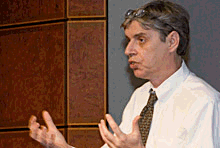
Typical street scene in Santa Ana, El Salvador. (Photo: iStock)
IMF Survey: Figuring Out the Fracas About the Flat Tax
February 12, 2007
- Little economic evidence that flat taxes boost work incentives
- Flat taxes have a somewhat beneficial effect on compliance with tax laws
- Details of flat tax regimes differ vastly across countries
Discussing the flat tax always generates heated debate—even about its definition.

Michael Keen: `There is a basic ambiguity when people talk about the flat tax' (Thomas Dooley/IMF)
FLAT TAX DEBATE
Proponents claim its simplicity and efficiency can be a key to economic success, while critics argue that it has little effect on economic activity and can be unfair.
A new study by the IMF's Michael Keen, Yitae Kim, and Ricardo Varsano examines the impact of the flat tax in countries where it has been in effect for more than a decade. The authors find little economic evidence that flat taxes boost work incentives, but suggest they have a somewhat beneficial effect on compliance with tax laws. And they question, given political economy considerations, the sustainability of the flat tax in the years ahead.
The study, which has sparked considerable debate, provided the basis for a January 25 IMF seminar. Keen and Varsano were joined by Kevin Hassett (American Enterprise Institute) and Leonard Burman (Urban Institute) for a panel discussion.
New kid on the block
Progressive taxes, where rates rise with income, have long been the norm. They are seen as fairer and better at stabilizing income over the business cycle than flat taxes. But, since 1994 this conventional view has been challenged, with Estonia, Georgia, Lithuania, Latvia, Romania, Russia, the Slovak Republic, and Ukraine adopting taxes with a single strictly positive marginal tax rate on labor income.
Keen pointed out that these flat tax regimes differ considerably from the concept of the flat tax assumed in academic and policy debates in the United States—the so-called Hall-Rabushka tax, which is a combination of a cash-flow tax on business income and a tax on workers' income, both levied at the same, single rate. Moreover, the details of the flat tax regimes differ vastly across countries and, although some countries adopted a single positive marginal rate near the highest from their previous tax regime, others adopted a marginal tax rate near the lowest.
The evidence does not give much comfort to either side in the debate, Keen said. Neither theory nor evidence bear out the critics' fear that the flat tax is inequitable or weakens automatic stabilizers. The "long-run sustainability of the flat tax remains unclear," Keen noted. Simple political economy models make it hard to explain why flat tax reforms redistribute from the middle of the income distribution to the two ends, he said, and why their adoption does not help countries deal with such vexing issues as how to treat internationally mobile capital income or how to tax the self-employed.
More evidence, please
Hailing the paper as "exceptionally valuable," Burman said he "did not realize that the flat taxes The Wall Street Journal was paying such homage to were not the Hall-Rabushka flat tax" and that, in fact, "many advocates of a flat tax in the U.S. would find the flat taxes as described in the paper to be grossly deficient in terms of their effects on economic growth." Hassett described the paper as "a huge and productive undertaking" and a valuable review of the flat tax regimes that countries had actually put in place. But he criticized the paper for not making enough of an effort "to understand the effects of reforms." Because the data used in the paper were limited to revenues for a short time, he added, it was difficult to accept the authors' "sweeping statements" about what the evidence shows. Burman agreed that determining "whether a flat taxes raises or lowers social welfare" is an important question that would require the analysis of a broader data set. The debate, no doubt, will continue to be heated.


